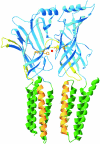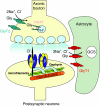GABA and glycine as neurotransmitters: a brief history
- PMID: 16402094
- PMCID: PMC1760744
- DOI: 10.1038/sj.bjp.0706443
GABA and glycine as neurotransmitters: a brief history
Abstract
gamma-Aminobutyric acid (GABA) emerged as a potentially important brain chemical just over 50 years ago, but its significance as a neurotransmitter was not fully realized until over 16 years later. We now know that at least 40% of inhibitory synaptic processing in the mammalian brain uses GABA. Establishing its role as a transmitter was a lengthy process and it seems hard to believe with our current knowledge that there was ever any dispute about its role in the mammalian brain. The detailed information that we now have about the receptors for GABA together with the wealth of agents which facilitate or reduce GABA receptor mechanisms make the prospects for further research very exciting. The emergence of glycine as a transmitter seems relatively painless by comparison to GABA. Perhaps this is appropriate for the simplest of transmitter structures! Its discovery within the spinal cord and brainstem approximately 40 years ago was followed only 2 years later by the proposal that it be conferred with 'neurotransmitter' status. It was another 16 years before the receptor was biochemically isolated. Now it is readily accepted as a vital spinal and supraspinal inhibitory transmitter and we know many details regarding its molecular structure and trafficking around neurones. The pharmacology of these receptors has lagged behind that of GABA. There is not the rich variety of allosteric modulators that we have come to readily associate with GABA receptors and which has provided us with a virtual treasure trove of important drugs used in anxiety, insomnia, epilepsy, anaesthesia, and spasticity, all stemming from the actions of the simple neutral amino acid GABA. Nevertheless, the realization that glycine receptors are involved in motor reflexes and nociceptive pathways together with the more recent advent of drugs that exhibit some subtype selectivity make the goal of designing selective therapeutic ligands for the glycine receptor that much closer.
Figures





References
-
- APRISON M.H., WERMAN R. The distribution of glycine in cat spinal cord and roots. Life Sci. 1965;4:2075–2083. - PubMed
-
- BARBER R.P., VAUGHN J.E., SAITO K., MCLAUGHLIN B.J., ROBERTS E. GABAergic terminals are presynaptic to primary afferent terminals; in the substantia gelatinosa of the rat spinal cord. Brain Res. 1978;141:35–55. - PubMed
-
- BETZ H., HARVEY R.J., SCHLOSS P.2000Structures, diversity and pharmacology of glycine receptors and transporters Pharmacology of GABA and Glycine Neurotransmissioned. Mohler, H. pp 375–401.Berlin, Heidelberg: Springer-Verlag
-
- BLOOMENTHAL A.B., GOLDWATER E., PRITCHETT D.B., HARRISON N.L. Biphasic modulation of the strychnine-sensitive glycine receptor by Zn2+ Mol. Pharmacol. 1994;46:1156–1159. - PubMed
Publication types
MeSH terms
Substances
Grants and funding
LinkOut - more resources
Full Text Sources
Molecular Biology Databases

